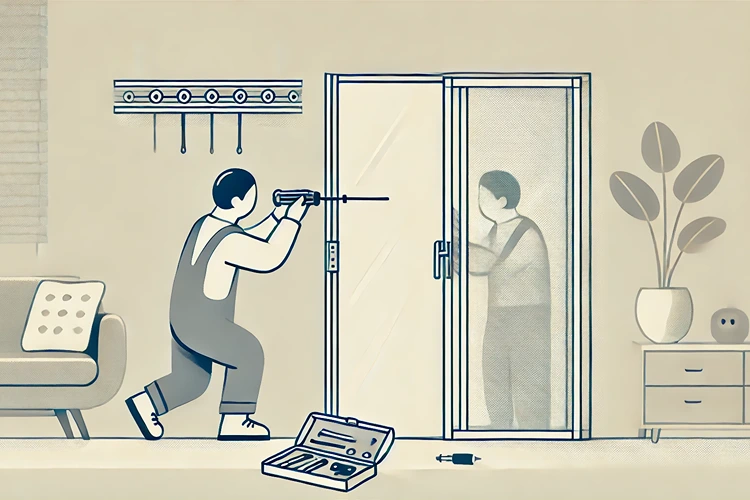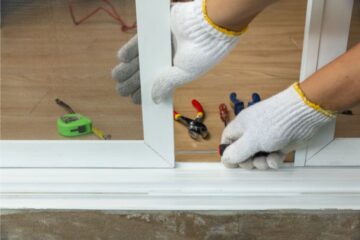Step-by-Step Guide for Replacing Sliding Door Rollers

Replacing sliding door rollers might seem like a daunting task, but with the right guidance, it’s a project you can tackle on your own. Whether your door is sticking, making noise, or just not sliding smoothly anymore, worn-out rollers are often the culprit. In this guide, we’ll walk you through every step of the process, from identifying the problem to selecting the right tools, and finally, successfully replacing the rollers. Let’s dive into how you can restore your sliding door to its former glory.
Why Replace Sliding Door Rollers?
Sliding doors are a popular choice for many homes because they save space and allow for easy access to outdoor areas. However, over time, the rollers that make these doors glide smoothly can wear out, leading to several issues:
- Difficulty in opening or closing the door.
- Grinding or squeaking noises.
- The door coming off its track.
- Increased effort needed to move the door.
When these problems arise, it’s time to consider replacing the rollers. This will not only improve the functionality of the door but also extend its lifespan.
What Tools and Materials Do You Need?
Before you start the replacement process, gather the necessary tools and materials. Having everything on hand will make the job smoother and quicker.
Essential Tools:
- Screwdriver (flathead and Phillips)
- Adjustable wrench
- Needle-nose pliers
- Putty knife
- Rubber mallet
- Measuring tape
Materials You’ll Need:
- Replacement rollers (make sure they match your door model)
- Lubricant (silicone-based)
- Cleaning cloth
- Vacuum cleaner (optional, but useful for cleaning tracks)
How to Identify the Right Rollers for Your Door?
Choosing the correct replacement rollers is crucial for the smooth operation of your sliding door. Here’s how you can identify the right ones:
Check the Manufacturer’s Information
Look for any labels or stamps on the door or the old rollers that might indicate the manufacturer and model. This information can help you find the exact replacement parts.
Measure the Existing Rollers
If you can’t find the manufacturer’s information, measure the existing rollers. Take note of the diameter of the wheels, the width of the roller housing, and the length of the axle. This will help you find a compatible replacement.
Consult a Professional or Supplier
If you’re unsure about the measurements or the type of rollers you need, consult a professional or a local hardware store. They can guide you in selecting the correct replacement based on your measurements or door model.
Step-by-Step Guide to Replacing Sliding Door Rollers
Now that you have the right tools and rollers, it’s time to start the replacement process. Follow these steps carefully to ensure a smooth operation.
Step 1: Remove the Sliding Door
The first step is to remove the door from its track. This might sound intimidating, but with a bit of care, it’s manageable.
- Start by loosening the screws on the roller adjustment mechanism located at the bottom of the door.
- Use the putty knife to gently pry the door upwards, allowing the rollers to come off the track.
- Once the door is free, carefully tilt it and remove it from the track. It’s advisable to have someone assist you, as sliding doors can be heavy.
Step 2: Access the Rollers
With the door safely removed, it’s time to access the rollers.
- Lay the door flat on a soft surface to prevent damage.
- Locate the roller screws, usually found at the bottom of the door.
- Use a screwdriver to remove the screws and take out the old rollers.
Step 3: Install the New Rollers
Installing the new rollers is a straightforward process.
- Place the new rollers in the housing, ensuring they fit snugly.
- Screw the rollers in place, making sure they are secure but not overtightened.
- Adjust the roller height using the adjustment screws to ensure they align with the track when the door is reinstalled.
Step 4: Reinstall the Sliding Door
After the new rollers are in place, it’s time to reinstall the door.
- Lift the door and angle it so that the rollers catch the track.
- Gently lower the door into the track and slide it back and forth to ensure it moves smoothly.
- If the door doesn’t slide properly, adjust the roller height using the screws until it operates smoothly.
Common Mistakes to Avoid When Replacing Sliding Door Rollers
Replacing sliding door rollers isn’t overly complex, but there are some common mistakes you should avoid:
- Using the wrong size rollers: Always measure and confirm the size before purchasing replacements.
- Overtightening screws: This can cause the rollers to malfunction or break.
- Not adjusting the rollers properly: Ensure the rollers are aligned with the track to prevent future issues.
Helpful Hint:
When removing the sliding door, always have a friend assist you. Sliding doors are often heavy and can be difficult to manage alone. Additionally, take care not to damage the door or surrounding frame during removal and installation.
Common Sliding Door Roller Issues and Their Causes
| Issue | Possible Cause | Solution |
|---|---|---|
| Door Sticks While Sliding | Dirt and debris in the track | Clean the track regularly and use a vacuum to remove debris |
| Grinding Noise | Worn or damaged rollers | Replace the rollers with high-quality replacements |
| Door Pops Off Track | Misaligned or broken rollers | Check and replace misaligned rollers and ensure track is level |
| Difficulty Opening or Closing | Rollers not properly adjusted | Adjust the roller height to ensure proper alignment |
| Rollers Rusting | Exposure to moisture | Use stainless steel rollers and consider a door cover for protection |
How to Maintain Your Sliding Door Rollers
Proper maintenance can extend the life of your sliding door rollers and keep them functioning smoothly.
Regular Cleaning
Clean the track regularly to prevent dirt and debris from clogging the rollers. Use a vacuum to remove loose dirt, followed by wiping the track with a damp cloth.
Lubrication
Apply a silicone-based lubricant to the track and rollers. Avoid using oil-based lubricants, as they can attract dust and dirt, leading to more frequent clogs.
Inspect for Wear and Tear
Periodically inspect the rollers for signs of wear. If you notice the door becoming difficult to slide or making unusual noises, it might be time for a replacement.
When to Call a Professional?
While replacing sliding door rollers is a DIY-friendly task, some situations may require professional help:
- If the door is extremely heavy or difficult to remove.
- If the track is damaged or requires replacement.
- If you’re unsure about the roller type or installation process.
How to Choose the Right Rollers for Different Types of Sliding Doors
Not all sliding doors are the same, and different types of doors require different rollers. Here’s how you can choose the right rollers for your specific door type.
Aluminum Sliding Doors
Aluminum sliding doors are common in many homes due to their durability and lightweight nature. For these doors, you’ll need rollers that can handle the metal’s weight while providing smooth operation.
- **Material:** Opt for stainless steel rollers, as they resist rust and corrosion, which is essential for aluminum doors exposed to the elements.
- **Size:** Measure the current rollers or consult the manufacturer to ensure the replacements fit perfectly.
- **Weight Capacity:** Check the weight rating of the rollers to ensure they can support the door’s weight without causing strain.
Vinyl Sliding Doors
Vinyl doors are popular for their energy efficiency and aesthetic appeal. However, they require a different type of roller compared to aluminum doors.
- **Material:** Nylon rollers are a good choice for vinyl doors, as they are lightweight and won’t scratch the door material.
- **Compatibility:** Ensure the rollers are designed for vinyl doors, as using the wrong type can damage the door frame over time.
- **Smooth Operation:** Look for rollers with ball bearings, as they offer smoother movement, which is ideal for the lighter vinyl doors.
Wooden Sliding Doors
Wooden sliding doors add a touch of elegance to any home but require heavy-duty rollers due to their weight.
- **Material:** Heavy-duty stainless steel or brass rollers are ideal for wooden doors to ensure they can support the door’s weight.
- **Durability:** Choose rollers with a high weight capacity and durable construction to handle the stress of the heavier wooden material.
- **Smooth Glide:** Given the weight, consider rollers with high-quality ball bearings to facilitate smooth operation and reduce the strain on the door frame.
How to Avoid Roller Damage and Extend Their Lifespan
Taking care of your sliding door rollers can significantly extend their lifespan and keep your door functioning smoothly for years.
Avoid Overloading the Door
One of the most common causes of roller damage is overloading the door with excessive weight. Whether it’s hanging heavy decorations or placing objects against the door, this can put unnecessary strain on the rollers.
- Keep the door free of heavy items and avoid using it to support weight.
- Ensure the door is properly aligned and balanced to distribute the weight evenly across the rollers.
Regular Maintenance Checks
Regular maintenance can help catch issues before they lead to roller failure. Schedule periodic checks to ensure everything is functioning correctly.
- Check the door’s alignment and make adjustments as necessary.
- Inspect the rollers for signs of wear, such as flat spots or rust.
- Clean the tracks and rollers regularly to prevent debris from causing damage.
Use the Right Lubricant
Using the correct lubricant is essential for preventing roller damage. Silicone-based lubricants are generally recommended because they don’t attract dirt and are safe for most door materials.
- Avoid oil-based lubricants, as they can attract dust and debris, leading to clogging and wear.
- Apply lubricant to the tracks and rollers every few months to keep them running smoothly.
Helpful Hint:
If your sliding door is exposed to the elements, consider using weatherproof rollers or adding a door cover to protect it from rain, snow, and dirt. This will help extend the lifespan of both the door and the rollers.
What to Do If Your Sliding Door Still Won’t Slide Smoothly?
Even after replacing the rollers, you might still experience issues with your sliding door. Here’s what to check if your door isn’t gliding as smoothly as it should.
Check the Track Alignment
A misaligned track can cause the door to drag or stick, even with new rollers. Here’s how to check and fix this issue:
- Inspect the track for bends or damage that could be affecting the door’s movement.
- Use a level to ensure the track is perfectly horizontal. If it’s not, adjust the track or the door frame accordingly.
- If the track is damaged, you might need to replace it to restore smooth operation.
Inspect the Door Frame
Sometimes, the issue lies with the door frame rather than the rollers. A warped or damaged frame can cause the door to stick.
- Check the frame for warping or damage, especially if the door is old or has been exposed to extreme weather conditions.
- If the frame is damaged, it may need to be repaired or replaced to allow the door to function properly.
Recheck the Rollers
Even new rollers can sometimes be faulty or improperly installed. If the door still doesn’t slide smoothly, double-check the rollers.
- Ensure the rollers are securely attached and not wobbling.
- Verify that the rollers are the correct size and type for your door.
- If you suspect the rollers are defective, consider replacing them with a different brand or model.
Benefits of Replacing Sliding Door Rollers Yourself
While it’s always an option to hire a professional, there are several benefits to replacing sliding door rollers yourself.
Cost Savings
Hiring a professional can be expensive, especially if your sliding door requires significant work. By doing it yourself, you can save money on labor costs.
- DIY replacement of sliding door rollers typically only costs the price of the rollers and any necessary tools.
- Even if you need to purchase tools, these can be used for future projects, making it a worthwhile investment.
Personal Satisfaction
There’s a sense of accomplishment that comes from completing a home improvement project yourself.
- Successfully replacing the rollers gives you a feeling of independence and self-reliance.
- It also allows you to learn new skills that can be applied to other DIY projects around the home.
Custom Control
When you do the job yourself, you have full control over the materials and methods used.
- You can choose high-quality rollers and tools that meet your specific needs.
- You can also ensure the job is done to your standards, without having to rely on someone else’s expertise.
FAQs
Wrapping Up
Replacing sliding door rollers is a straightforward process that can greatly improve the functionality of your door, making it glide smoothly and effortlessly. By following this step-by-step guide, you can tackle the replacement with confidence, ensuring the job is done right. Whether you’re dealing with aluminum, vinyl, or wooden doors, choosing the right rollers and maintaining them properly can extend the life of your door and prevent future issues.
Remember, regular maintenance and timely replacement of rollers can save you from bigger problems down the line. The key is to address the signs of wear early, select the right materials, and follow the correct installation procedures. If you encounter challenges, don’t hesitate to consult a professional to ensure your door operates at its best.
We hope this guide has provided you with the knowledge and confidence to take on this home improvement project. Keep your sliding doors in top condition by following the tips and advice shared here, and enjoy the benefits of a smoothly operating door for years to come.


